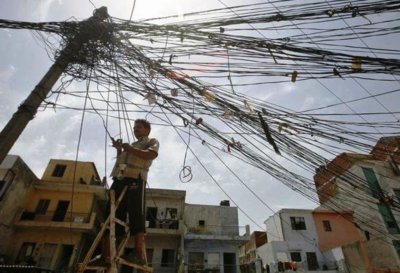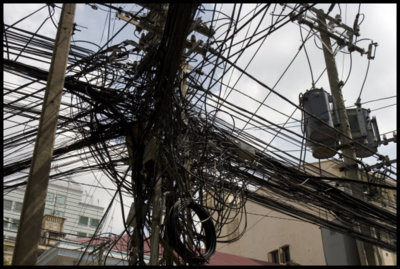That's the sort of practice that will lose a guy his license in this country.take the wires coming in to the box in the 2nd garage, nip off a few strands until it fits into a 60a breaker,
You are using an out of date browser. It may not display this or other websites correctly.
You should upgrade or use an alternative browser.
You should upgrade or use an alternative browser.
NEW SHOP NEED ELECTRICAL HELP
- Thread starter XMAN JR
- Start date
- Local time
- 12:30 PM
- Joined
- Jul 1, 2015
- Messages
- 6,471
- Reaction score
- 8,091
Sorry I have 200 amp panel in the house. I have a 100 amp breaker in it w/ a 100 amp wire going to a 100amp sub panel. question is can I add a 100 amp breaker to that sub panel to feed another sub panel in a 2nd garage
As a registered Professional Electrical Engineer, I would say yes, the 100 amp breaker, in the house's 200 amp panel, is used as a sub feed main for the garage panel's 100 amp main breaker. Could this panel (1st garage panel) have a sub feed breaker to feed a panel in the second garage, yes, providing the ampacity of the wire is not exceeded. I would suggest that second subfeed breaker (feeding the second garage's panel) be no greater than 60 amps. However, b4 proceeding, you should inquire as to the acceptance of what is being proposed by the local Boro, township or governing body. Failure to do do may result in a decline of your building permit and the POSSIBILITY of having your fire insurance voided. All work should be done by a licensed professional electrician and inspected by the governing body. Ask someone who is knowledgeable and NOT your next door's neighbor's brother-in-law's cousin's best buddy's friend's sister's husband....unless he is an electrician.
BTW.... the correct explanation description of the service is: 240 / 120 volt service NOT 220 volt. The reason for the possibility of acceptance is: the diversity factor of all CONNECTED loads being energized at the same time. The diversity fsctor is USUALLY figured at 20 - 25% of the total connected load.
I would recommend Square D QO circuit breakers and panels or Siemens AND local ground fault circuit interrupters (GFCI) and Arcing Fault Circuit Interrupters as required by the latest edition of the National Electrical Code (NEC). To not having acceptance and spproval by your jurisdictional organizations is NOT a good idea in any regard. Just my opinion of course.
BOB RENTON
beanhead
Easily Offensive
Exactly.However, b4 proceeding, you should inquire as to the acceptance of what is being proposed by the local Boro, township or governing body. Failure to do do may result in a decline of your building permit and the POSSIBILITY of having your fire insurance voided.
BOB RENTON
I completely understand being on a tight budget, but as a responsible homeowner, you must find a way to do the job properly. Think about what's at stake..
I feel so inadequate now.....I'm a mere Registered Electrician.As a registered Professional Electrical Engineer,
I didn't realise that 'Professional' was a qualification also.
- Local time
- 12:30 PM
- Joined
- Jul 1, 2015
- Messages
- 6,471
- Reaction score
- 8,091
Absolutely....the ampacity of the connection is significantly reduced by cutting off some of the conductors.That's the sort of practice that will lose a guy his license in this country.
As cosgig #38 eluded to "Big Al", who seems to know everything about everything, could not be more wrong about his philosophy in trimming conductors of a wire just to enable it to fit into the lug. It's persons like this who accept and preach this practice give the discipline a black eye. Perhaps the other noted areas of "expertise" are also compromised....a definite case for doing one's own due diligence rather than acceptance of someone else unqualified opinion.
BOB RENTON
- Local time
- 1:30 PM
- Joined
- Jan 29, 2018
- Messages
- 21,878
- Reaction score
- 70,022
- Location
- Midland Ontario, Canada
LOL Roger, we all have some deductive disqualification. I've been an Electo- Mechanical Engineer since 1982... started my own business in 1985 and after that have never paid dues to be "legal" as I never needed to officially use my "knowledge". Doesn't change that I know when **** is WRONG...
XMAN JR
Well-Known Member
OK When I bought the house the inspector said that the "new 200 amp panel in the house w/ the 100 amp breaker & wire coming from that to the 1st garage & subpanel was OK. So what im gonna do is replace the wire from the 1st garage to the 2nd garage. Its about 30-35 feet between the garages. Right now the subpanel in the 2nd garage only feeds a few shop lights, a dusk to dawn light & the swimming pool pump. That's if I can pull that wire out. lol What size wire " going from garage to garage do you guys think I should use ?
- Local time
- 12:30 PM
- Joined
- Jul 1, 2015
- Messages
- 6,471
- Reaction score
- 8,091
I feel so inadequate now.....I'm a mere Registered Electrician.
I didn't realise that 'Professional' was a qualification also.
It may be different in New Zealand, but In the States, a Registered Professional Engineer (specific to the chosen dicipline - Electrical, Mechanical, Chemicial, Structural, Civil, etc.) Is an engineer who has undergone several years of training, taken several intermediate proficiency tests, including the extensive Engineer In Training (EIT), which involves interdisciplinary aspects including economics, methodology, safety and health, OSHA, NFPA, NEC and most importantly Ethics. After psssing all the criteria and spending the requisite "time in grade" and passing a final examination given by and judged by his/her peers is granted a Professional Engineer status allowing the person to legally sign documents and to accept responsibility for said actions. It's not as simple as calling one's self a "professional" as considerable more involvement is required.
BOB RENTON
We had to begin our careers with an 8,000 hour apprenticeship (although this has been watered down over the years). After this time you apply for registration, which includes a hefty fee to the Govt body, a letter of recommendation, and proof of the required minimum of variety or work completed by yourself - basically these days a log book or work completed, and signed off. In my day it was called a "Certificate of Due Completion". Then since 1992 (I think from memory) we had to re-register every two years, and successfully pass a CPR, First Aid and Electrical refresher course to maintain our ticket to practice....which is magically called a Practicing Licence. This Licence also carries a fee...surprise surprise. Failure to re-licence by the due date can mean you are struck off the Register,m and have to re-apply. e also have differing grades of the trade and this is signified on our ticket by the prefix letter - E for Electrician as an example.It may be different in New Zealand, but In the States, a Registered Professional Engineer (specific to the chosen dicipline - Electrical, Mechanical, Chemicial, Structural, Civil, etc.) Is an engineer who has undergone several years of training, taken several intermediate proficiency tests, including the extensive Engineer In Training (EIT), which involves interdisciplinary aspects including economics, methodology, safety and health, OSHA, NFPA, NEC and most importantly Ethics. After psssing all the criteria and spending the requisite "time in grade" and passing a final examination given by and judged by his/her peers is granted a Professional Engineer status allowing the person to legally sign documents and to accept responsibility for said actions. It's not as simple as calling one's self a "professional" as considerable more involvement is required.
BOB RENTON
We can also be randomly audited on work, and be required to repair any work not up to standard - whether or not you actually did the faulty work - the power of these Auditors is incredible. I got hung once, and for something I didn't do. My mistake was to not exclude everything in the house that I didn't touch or alter. And this happened 6 months after I was at that property. Serious cases of misconduct or faulty work can land you in a disciplinary hearing - which is very difficult to win. Not many people get away with that one. And in NZ, if a homeowner and an Electrician make the same type of faulty work on different jobs, the homeowner gets a softer penalty.....reason being that the Electrician should know better.
451Mopar
Well-Known Member
I still don't understand the grounding / bonding rules. Like a Sub panel that is attached to the house does not get a ground rod to earth as it would create multiple ground paths. I would think a sub panel in an out building should be the same, but now it is several feet away from the main breakers ground? I would think if the building is fairly far away, the circuit should run through an isolation transformer and then ground the out buildings panel(s)?
I am not an electrician, that is why I don't know all the codes. I am an electrical engineer, I just don't work commercial power distribution.
I am not an electrician, that is why I don't know all the codes. I am an electrical engineer, I just don't work commercial power distribution.
OK When I bought the house the inspector said that the "new 200 amp panel in the house w/ the 100 amp breaker & wire coming from that to the 1st garage & subpanel was OK. So what im gonna do is replace the wire from the 1st garage to the 2nd garage. Its about 30-35 feet between the garages. Right now the subpanel in the 2nd garage only feeds a few shop lights, a dusk to dawn light & the swimming pool pump. That's if I can pull that wire out. lol What size wire " going from garage to garage do you guys think I should use ?
6/3 with a ground, stranded copper would run a 60a sub. I would buy it from a supply house, as it’s much cheaper than the big box stores. I would also put it in conduit. I would also run it on a 60a breaker at each end. That would be more than adequate to run what you have, and allow for future upgrades.
XMAN JR
Well-Known Member
Thanks ill look for that wire. The old wire is already in conduit. Im hoping I can pull it out.6/3 with a ground, stranded copper would run a 60a sub. I would buy it from a supply house, as it’s much cheaper than the big box stores. I would also put it in conduit. I would also run it on a 60a breaker at each end. That would be more than adequate to run what you have, and allow for future upgrades.
NJRR
Well-Known Member
If I'm not mistaken, you don't have to run a new wire from the second to the first garage. You can pull the existing Aluminum wire from the panels, and then transition them down to a #6 copper cable to fit into the 60A breakers. You can do this on both ends. You just need a junction box and the properly sized Aluminum/copper connectors that will fit your wires on both ends. Might be less work and cheaper than pulling the old cable from the conduit and pulling the new cable through it. I defer to the electricians and EE's in this thread if I am mistaken.Thanks ill look for that wire. The old wire is already in conduit. Im hoping I can pull it out.
XMAN JR
Well-Known Member
mmm that's a thought just might have to check in on that thanksIf I'm not mistaken, you don't have to run a new wire from the second to the first garage. You can pull the existing Aluminum wire from the panels, and then transition them down to a #6 copper cable to fit into the 60A breakers. You can do this on both ends. You just need a junction box and the properly sized Aluminum/copper connectors that will fit your wires on both ends. Might be less work and cheaper than pulling the old cable from the conduit and pulling the new cable through it. I defer to the electricians and EE's in this thread if I am mistaken.
- Local time
- 12:30 PM
- Joined
- Jul 1, 2015
- Messages
- 6,471
- Reaction score
- 8,091
This item is called a split bolt connector, originally made by Burndy-Servit, now made by other manufacturers and is quite effective at joining two or multiple conductors, provided it is used as intended.
BOB RENTON
We call those "Line taps" here - because you can tap directly from a line without cutting.This item is called a split bolt connector, originally made by Burndy-Servit, now made by other manufacturers and is quite effective at joining two or multiple conductors, provided it is used as intended.
BOB RENTON
Maybe an earlier poster was referring to "Shear bolt connectors" - a solid connector with bolts that are designed to break off with correct torque applied...
These are then oversleeved with suitable heatshrink and HV tape. Available with a central barrier to allow for mixed-metal conductors.
I got called in to have a look at a farm pump shed last Thursday. Met the farmer (an excitable Irishman) and he happy to show me what he thought was wrong. When I looked at the installation, I was appalled at the state of the equipment. DOL Starter box with no cover...so he just pushed the contactor start button...obviously someone had swapped out the vcontactor at some stage and re-used the original enclosure - which had a different set of contact points for Stop/Start. Then, the pressure vessel for the pump was jammed into the makeshift tin clad shack, leaving a tight squeeze to access the contactor. And of course, the meterbox was unable to be opened because of the hinge orientation, and the aforementioned pressure vessel blocking access. 
I go outside and test the pump motor isolator....lost one phase....that aint going to work. b Then the helpful farmer points skyward - one of the overhead lines had a broken insulator...and the tail had chaffed through on the point of entry box. So I called the local power supplier and logged a fault to have a pole fuse checked, and view the options. Long story short - a new pole is needed, the crossbar is rotten, all isolators are rusted out, and so the Lineman pulled all 3 pole fuses for safety. This sent the excitable farmer off on a tirade of abuse towards the Lineman.....racial abuse ensued etc....which the lineman just ignored and laughed off....he's heard it all before.
After the farmer had cooled off, I rang around for a contractor to come and replace the pole. Found one who was able to do it the next day. Then the farmer says he'd do it himself....what a nightmare. I could just imaging him doing it too. I pointed out to him that even though the pole was on private property, and the lines were dead, that he is not authorised or qualified to carry out such work, and that anyone arriving to connect his 'work' would not be able to sign off the job or liven up either, because of the unauthorised and unsupervised work carried out.
I left him to it....with the knowledge that I had done what I could for him, and an arrangement was made for the repairs, and that my services were no longer required. I'll drive past on Friday and see what happened.
BTW...the farmer informed me that the line had been hanging down for at least a week....but the day I was told, it became extremely urgent, as his cattle had to drink from a trough on town supply, and not the farm bore supply. Planning people.....planning.
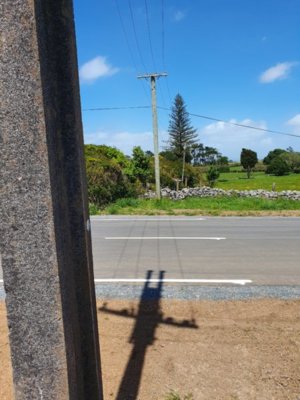
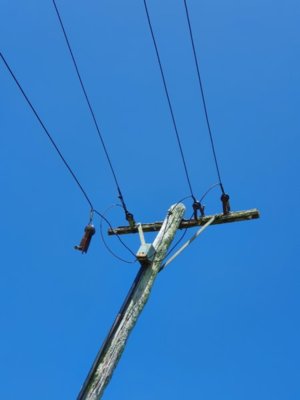
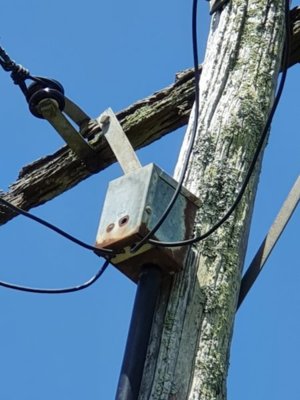
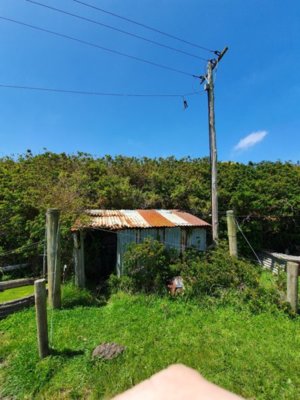
I go outside and test the pump motor isolator....lost one phase....that aint going to work. b Then the helpful farmer points skyward - one of the overhead lines had a broken insulator...and the tail had chaffed through on the point of entry box. So I called the local power supplier and logged a fault to have a pole fuse checked, and view the options. Long story short - a new pole is needed, the crossbar is rotten, all isolators are rusted out, and so the Lineman pulled all 3 pole fuses for safety. This sent the excitable farmer off on a tirade of abuse towards the Lineman.....racial abuse ensued etc....which the lineman just ignored and laughed off....he's heard it all before.
After the farmer had cooled off, I rang around for a contractor to come and replace the pole. Found one who was able to do it the next day. Then the farmer says he'd do it himself....what a nightmare. I could just imaging him doing it too. I pointed out to him that even though the pole was on private property, and the lines were dead, that he is not authorised or qualified to carry out such work, and that anyone arriving to connect his 'work' would not be able to sign off the job or liven up either, because of the unauthorised and unsupervised work carried out.
I left him to it....with the knowledge that I had done what I could for him, and an arrangement was made for the repairs, and that my services were no longer required. I'll drive past on Friday and see what happened.
BTW...the farmer informed me that the line had been hanging down for at least a week....but the day I was told, it became extremely urgent, as his cattle had to drink from a trough on town supply, and not the farm bore supply. Planning people.....planning.




In India they have strict codes for wiring everything:
View attachment 860650 View attachment 860651

Similar threads
- Replies
- 10
- Views
- 485
- Replies
- 5
- Views
- 1K


